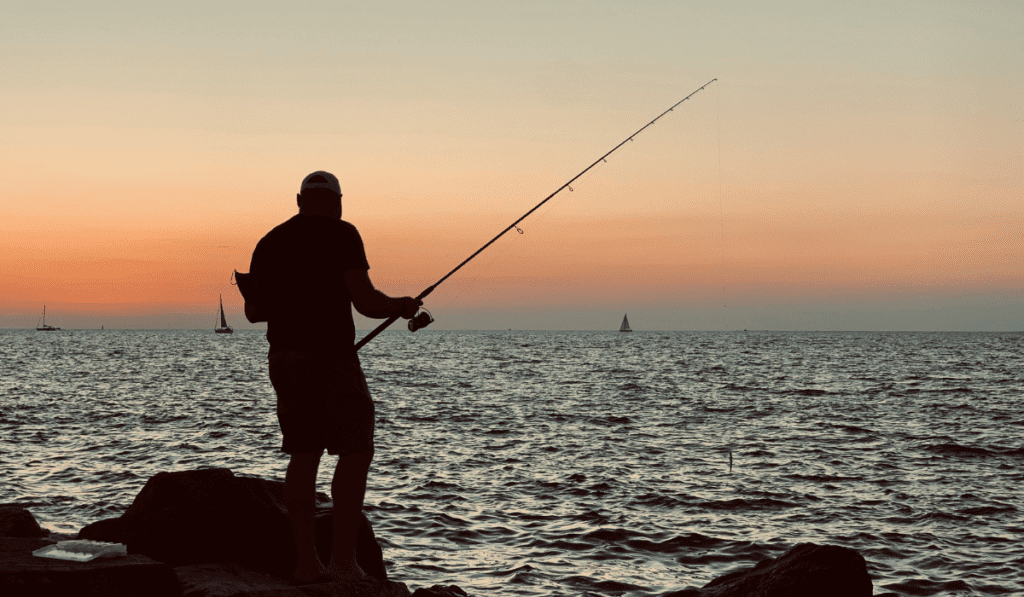Fishing can be a rewarding and enjoyable hobby, especially for beginners looking to start their fishing journey. To help you get started on the right foot, here are some essential fishing tips for beginners that will guide you through the basics and enhance your fishing experience.
Researching the fish habitat and behavior in your chosen area boosts your chances of success. Seasoned anglers often suggest starting with live bait, as it can be more enticing to fish. Always respect the environment by following appropriate catch-and-release practices and maintaining a clean fishing spot. Remember, patience and persistence are vital virtues in fishing – the more time you spend on the water, the more you’ll learn, and the better angler you’ll become.
Casting The Line Into Fishing
Fishing is a hobby that lets you relax and enjoy nature. With a simple rod and reel, anyone can start. It’s a great way to spend time with family and friends. Plus, you could catch your dinner!
Essential gear includes a rod, reel, line, and hooks. I am trying to remember a tackle box. You’ll also need bait, such as worms, minnows, or artificial lures. A sturdy fishing hat and sunglasses protect you from the sun.
| Gear Item | Description | Why It’s Essential |
| Fishing Rod | A pole to cast the line | Needed to reach far into the water |
| Reel | Device for winding the line | Helps in pulling the fish |
| Bait | Worms, minnows, or lures | Attracts and catches fish |
Choosing The Right Equipment
Beginners in fishing need the proper gear for a successful outing. Spinning reels are user-friendly, making them excellent choices for rookies. They are versatile and work well for lighter lures and baits. Baitcasting reels, on the other hand, offer more precision. Yet, they require practice to master due to potential line tangling.
Your first fishing rod should match your reel choice. Light to medium power rods are generally best for starters. These rods allow for better control and sensitivity. Look for a rod with a comfortable grip and a proper length.
The Bait Debate
Choosing the right bait is crucial for successful fishing. Beginners often wonder whether to use live bait or artificial lures. Live bait is very effective because it moves naturally and smells natural, attracting fish. Earthworms, minnows, and insects are popular live baits.
Artificial lures, conversely, are designed to mimic the look and movement of prey. They require more skill as you must make them seem alive to convince fish. Plastic worms, spinnerbaits, and jigs are standard artificial options. Each has its appeal to different fish species.
To catch a specific fish, learn what they eat. Research the preferred prey of your target fish and match your bait accordingly. A well-matched bait increases your chances of a good catch. Remember, the choice depends on the fish you aim to catch and the fishing environment.
Knot Tying Techniques
Knot tying is a crucial skill for any angler. Mastering basic knots will secure your hook on the line. Start with these essential knots:
- The Improved Clinch Knot – Good for small fish.
- The Palomar Knot is substantial and works well with braided lines.
- Double Surgeon’s Loop – Easy and versatile.
Set aside time to practice at home. Use different ropes and lines for practice. Doing so builds muscle memory. Thus, tying knots becomes second nature. Remember, practice makes perfect. Soon, you’ll tie these knots quickly and accurately, even on a rocking boat.
Understanding Fishing Licenses
Fishing licenses play a crucial role in conservation efforts. They help regulate fishing populations and ensure sustainable practices. Anglers contribute to wildlife and habitat protection through their license fees. Obtaining a license is crucial to enjoying your fishing journey legally and responsibly.
Securing a fishing license is typically a straightforward process. Start by checking your local Department of Fish and Wildlife website. Most states provide an online application system. Alternatively, visit a local tackle shop or outdoor retailer to purchase your license in person. Remember, licenses vary by state, age, and type of fishing, so choose the appropriate one for your needs.
Reading The Water
Understanding where fish live is critical to successful angling. Rivers, lakes, and streams have different zones where fish thrive. Structures like logs or rocks, water depth, and plants form natural fish habitats. Water movement can also indicate where fish may gather. Aiming for these spots increases catching chances.
Fishing is not just about luck; time plays a significant role. Early morning or late afternoon are often the best times to fish in freshwater. Fish are more active than searching for food. This is the magic hour, especially during warmer months—don’t take advantage of these peak periods for a rewarding experience.
Casting Basics
Mastering the overhead cast is crucial for all fishing novices. Start with your feet shoulder-width apart. Grip the rod near the base, elbow at your side. Swiftly flick the rod tip up and back. Stop the rod at a two o’clock position, then snap it forward. Finish with the tip pointing towards your target. This motion should be smooth and steady.
Standard errors can hinder your casting success. Line tangles often occur from rushed casts. To avoid this, ensure a timed pause on the back cast. This lets the line straighten fully. Uneven casting may be due to stiff wrist movement. Keep your wrist flexible and use your forearm. Remember, practice makes perfect. Keep trying, and you’ll see improvement.
Reeling Techniques
Mastering the drag system is vital for fishing success. A correctly set drag prevents line breaks during a catch. Beginners should first understand their reel type. Most reels feature a knob near the reel handle for drag adjustment. Before casting, pull the line with your hand. Adjust the drag knob until the line comes out with moderate resistance.
Reeling in a fish demands patience and skill. Keep the rod tip up and reel steadily. Take your time with this step. Feel the fish’s movements and adjust the reeling speed accordingly. A slow and steady approach gives better control. Practice makes perfect in reeling techniques.
Safe Fish Handling
Proper catch and release is crucial for fish population health. To ensure fish survival, handle them gently and briefly. Wet your hands before touching the fish. This protects their slime coat, which guards against infections.
Use barbless hooks for easier removal. Keep the fish in the water as much as possible. If taking a photo, do it quickly. Lastly, release the fish facing the current to help its breathing. Follow these steps for a successful release.
When handling fish for consumption, cleanliness is critical. Stainless steel or plastic cutting surfaces are best. They are easy to clean and will not hold germs. Use a sharp knife to ensure quick, humane kills. This is important for both respect and meat quality.
Navigating Local Regulations
Before casting your line, know the local fish size and bag limits. These rules safeguard fish populations. Your state’s wildlife agency has these details on its website. Keep a copy handy to avoid penalties.
Seasonal restrictions also affect fishing. Certain fish species can only be caught during specific times of the year. This helps them breed and grow. Always check the current season’s rules before planning your trip.
Joining The Fishing Community
Embarking on the journey of fishing requires connecting with fellow anglers. Angling clubs offer a wealth of knowledge and support. Beginners can find these clubs through local tackle shops, online forums, or community boards. These clubs often organize meet-ups, where lessons and tricks are shared.
Local tournaments and events serve as the perfect platform for those eager to test their skills. Participation hones your technique and embeds you deeper within the fishing community. Event listings can usually be found on club websites or through fishing shops. Events range from casual, family-friendly outings to more competitive tournaments, catering to all levels of expertise.
Advancing Your Angling Skills
Becoming a skilled angler takes practice and patience. Every trip to the water is a lesson. Reflect on each fishing outing; what worked, what didn’t? Each mistake paves the path to improvement. Keeping a journal can help capture insights and track your progress.
- Local fishing clubs offer collective wisdom and hands-on experience.
- Online forums and videos are great for quick tips and tricks.
- Fishing guides and books provide in-depth knowledge of techniques and species.
- Seminars and workshops can introduce new strategies and equipment.
Frequently Asked Questions For Fishing Tips For Beginners
What Basic Gear Do I Need For Fishing?
Beginners should start with a simple spinning rod and reel combo, hooks, sinkers, bobbers, and bait. A tackle box helps organize these essentials.
How Do I Select The Right Bait?
Choose bait based on the fish species in your area; standard options include worms for freshwater and cut bait for saltwater.
When Is The Best Time To Fish?
Fishing is often most productive during the early morning or late evening, especially when the water is more relaxed and fish are more active.
What Knots Should Beginners Learn First?
The Improved Clinch Knot is versatile and robust, ideal for attaching hooks, lures, and other tackle to your fishing line.
Can I Fish In Any Weather Conditions?
Certain conditions, such as light rain, can be good for fishing, but safety should always be prioritized, especially during thunderstorms or high winds.
Conclusion
Embarking on the journey of fishing equips you with far more than just a hobby; it’s an adventure in patience and skill. Remember that every pro angler started where you are now. Keeping these tips in hand can make your foray into the fishing world thrilling and rewarding.

